Fort Sumter
| Fort Sumter | |
|---|---|
|
IUCN category V (protected landscape/seascape)
|
|
 |
|
|
Fort Sumter
|
|
| Location | Charleston Harbor, Charleston, South Carolina |
| Coordinates | 32°45′8″N 79°52′29″W / 32.75222°N 79.87472°WCoordinates: 32°45′8″N 79°52′29″W / 32.75222°N 79.87472°W |
| Area | 234.74 acres (95.00 ha) |
| Authorized | April 28, 1948 |
| Visitors | 857,883 |
| Website | Fort Sumter National Monument |
|
Fort Sumter
|
|
| Built | 1811 |
| NRHP Reference # | 66000101 |
| Added to NRHP | October 15, 1966 |
Fort Sumter is a sea fort in Charleston, South Carolina, notable for two battles of the American Civil War. It was one of a number of special forts planned after the War of 1812, combining high walls and heavy masonry, and classified as Third System, as a grade of structural integrity. Work started in 1829, but was incomplete by 1860, when South Carolina seceded from the Union.
The First Battle of Fort Sumter opened on April 12, 1861, when Confederate artillery fired on the Union garrison. These were the first shots of the war, and continued all day, watched by many civilians in a celebratory spirit. The fort had been cut off from its supply line and surrendered the next day. The Second Battle of Fort Sumter (September 8, 1863) was a failed attempt by the Union to retake the fort, dogged by rivalry between army and navy commanders. Although the fort was reduced to rubble, it remained in Confederate hands until it was evacuated as General Sherman marched through South Carolina in February 1865.
Fort Sumter is open for public tours as part of the Fort Sumter National Monument operated by the National Park Service.
Named after General Thomas Sumter, Revolutionary War hero, Fort Sumter was built following the War of 1812, as one of a series of fortifications on the southern U.S. coast to protect the harbors. Construction began in 1829, and the structure was still unfinished in 1861, when the Civil War began. Seventy thousand tons of granite were imported from New England to build up a sand bar in the entrance to Charleston Harbor, which the site dominates. The fort was a five-sided brick structure, 170 to 190 feet (52 to 58 m) long, with walls five feet (1.5 m) thick, standing 50 feet (15.2 m) over the low tide mark. It was designed to house 650 men and 135 guns in three tiers of gun emplacements, although it was never filled near its full capacity.
...
Wikipedia


